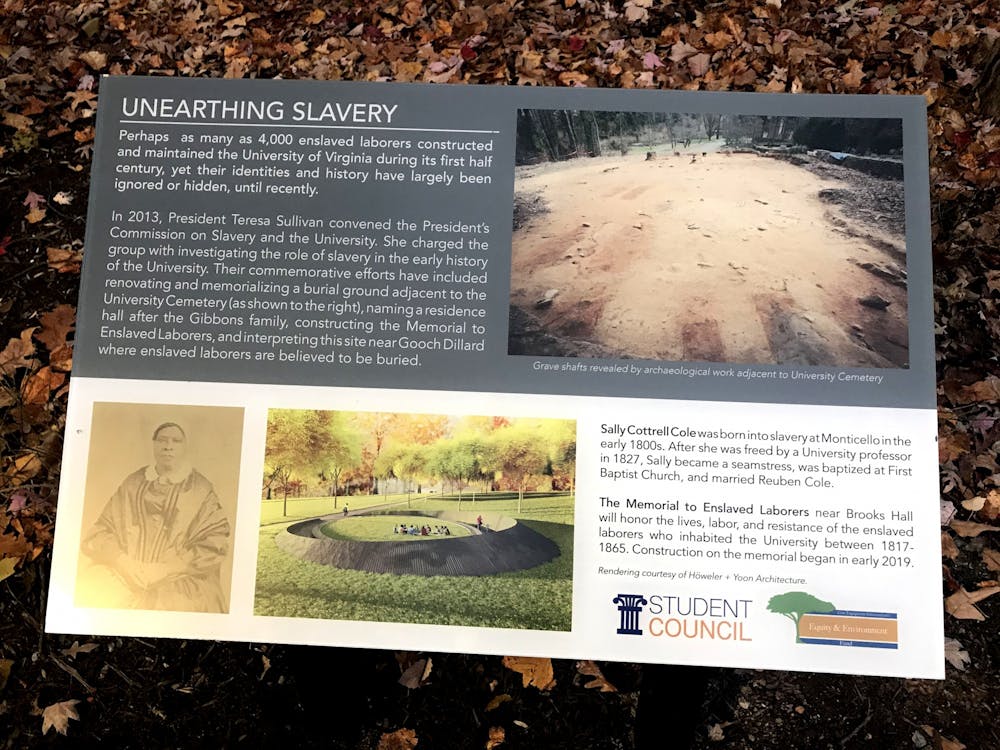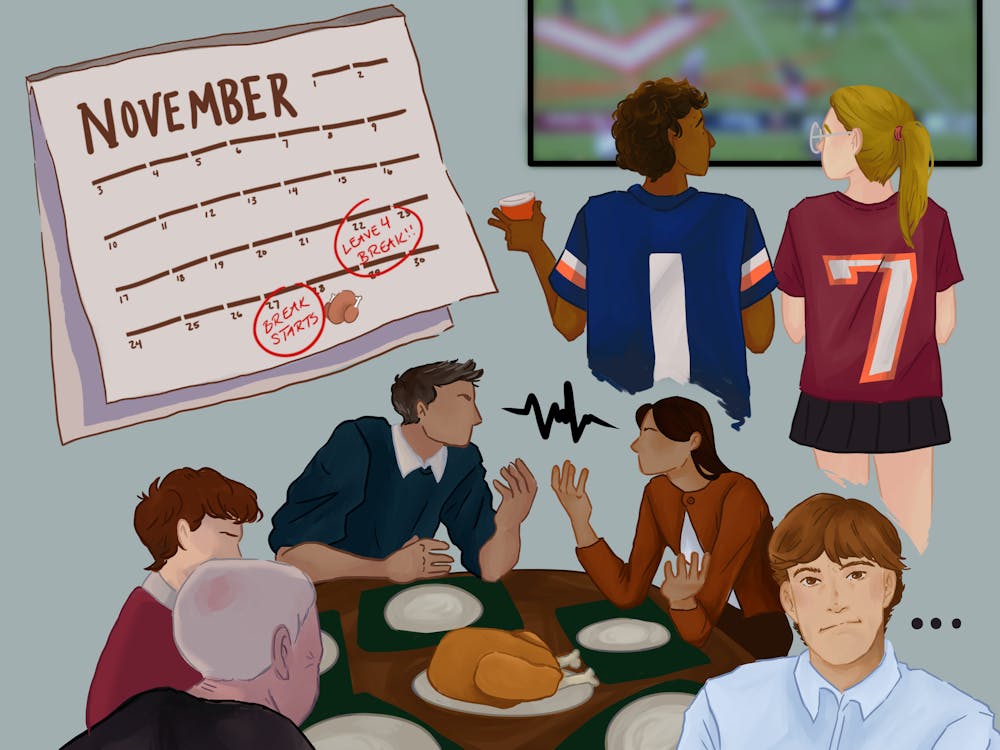The Student Council Buildings and Grounds Committee has designed and installed interpretive panels at the Gooch-Dillard Cemetery, in recognition of 70 unmarked gravesites of enslaved laborers. In a tweet announcing the decision, Student Council explained how the installation was “a part of the University’s continued efforts to acknowledge its complicity in the darkest chapter of our nation’s history.”
Ben Radomsky, a fourth-year College student and the chair of the Buildings and Grounds Committee, said that the students on the committee also consulted University Architect Alice Raucher and Professors Louis Nelson and Kirt von Daacke. Von Daacke, an assistant dean and history professor, and Louis Nelson, the University’s vice provost for academic outreach and professor of Architectural History, are members of the President’s Commission on Slavery and contributed to the recently-published “Educated in Tyranny: Slavery at Thomas Jefferson’s University.”
The content of the interpretive panels was finalized after research was conducted by the Student Council committee and in collaboration with faculty to ensure accuracy.
“Student Council hopes that students who live at Gooch-Dillard, and those who visit, will stop to read these panels and reflect on the site’s, and the University’s history” Radomsky said. “They are not comprehensive, but they are a jumping-off point, so I hope students will keep that history in mind and go off to learn more.”
The cemetery is located in front of the Gooch-Dillard dorms and within the Maury Family Cemetery. Previously, the site had only been demarcated by a small plaque embedded into a stone wall which had been installed in 1948.
“Student Council perceived the plaque that formerly was the sole acknowledgement of the site’s history to be inadequate because it is below eye-level,” Radomsky said. “Student Council steps up in situations wherein we feel that student concerns are not being adequately addressed by the University, and this was one such occasion.”
In addition to the Student Council’s actions, a group of first-year College students have compiled a petition that has circulated around the University, calling for greater education of the unmarked gravesites at the Gooch-Dillard cemetery.
In the petition, Kyndall Walker, Diana Moreno, Ephrata Yohannes, Abena Appiah-Ofori, Chloe Leon, Amanda Campbell and Ida Sampson, cite the Enslaved Laborer Tour, for which attendance was mandatory as a part of their Ideals and Injustices forums class, as the major source of inspiration for drafting their petition.
At the conclusion of the tour, Walker inquired about the absence of the Gooch-Dillard cemetery on the itinerary. When the rest of the group expressed a lack of awareness towards the gravesite’s existence, the students reacted in joining together and taking action.
Addressed to University President Jim Ryan, Dean of Students Allen Groves, Vice President Patricia Lampkin, Chief Officer for Diversity Dr. Marcus Martin, von Daacke and members of the Board of Visitors, the petition calls for the education of University students on the existence of the Gooch-Dillard gravesites and the University’s history with slavery.
The petition proposes that a brief history of the Maury family cemetery be included in the description of Gooch-Dillard dormitories on the University’s Housing and Residence Life website. Additionally, it says that every student assigned to Gooch-Dillard dorms should be presented with the same history of the cemetery from the Housing and Residence Life website in their housing assignment email.
Further, the petition states that it is essential that the University makes its Enslaved Laborer Tour and discussion of the history of slavery at University mandatory during Welcome Week. The petition includes that, following the presentation, “Residential Advisors ought to debrief and discuss the content with all first-year and transfer students.”
The group remarked that they had received instant feedback from the University community, supporting and encouraging their work. The petition has accumulated over 300 signatures as of press time.
They said the petition is not intended as an attack on the University or the changes and endeavors that have been made to address the University’s dark past.
Leon described the process of writing the petition as a “labor of love,” with the purpose of showing “just how much respect we have for the University in that we wanted to take the opportunity where we could help it improve.”
Like Student Council, the first-year students expressed disapproval of the former stone demarcation of the gravesites. Moreno remarked that the plaque is “hidden almost.”
“It’s not being showcased,” Moreno said. “You actually have to go and look.”
The group was aware of the interpretive panel installation by Student Council recognizing the Gooch-Dillard cemetery and said it was an important start to properly addressing the University’s history.
“We thought that this is a great first step but there is so much more work that has to be done,” Walker said.
She added that Student Council had reached out to them about working together in the future.
The students said they sent their petition to University administration Monday but have yet to receive a response. As of Wednesday, President Ryan’s office received the petition and said it will send a response to the students once it has been reviewed, according to Deputy Spokesperson Wes Hester.
Through the drafting of the letter, the students say they have developed a “sisterhood,” with meetings every Monday and the goal to set an example of advocacy for other students.
“If someone is uncomfortable about something here on Grounds, they can absolutely gather people up — people with the same commonality, and they can do something,” Moreno said. “You just need to have certain people who will stand by with you, and you can make things happen.”
Recontextualizing efforts have been a recent priority of the Student Council, as seen in the passage of a bill last semester that created the ad hoc committee on “Renaming, Recontextualizing and Removal.” Such efforts include a review of the possible removal of the Whispering Wall, due to its origins in honoring confederate soldier Frank Hume, and replacing the Wall with a Memorial to the Victims of Eugenics.
Recent calls to rename Alderman Library follow the 2017 renaming of Lewis House in the International Residential College, after biology prof. and eugenicist Ivey Lewis, to the Yen House, after W.W. Yen — the first international student to earn a bachelor of arts from the University. The Committee on Renaming, Recontextualizing and Removal plans to release their recommendation on the name change of Alderman by the end of the fall 2019 semester.
Similar consideration to rename buildings has occurred in the Curry School of Education and Ruffner Hall, as both namesakes were defenders of slavery. Criticism was also raised over a wing in the University’s hospital that was named after Paul Barringer, a prominent eugenicist and professor who is most famous for his racist essays. Last August, the wing was renamed the Collins Wing, in honor of University alumnus Dr. Francis S. Collins, who discovered genes associated with a number of diseases and led the Human Genome Project.





